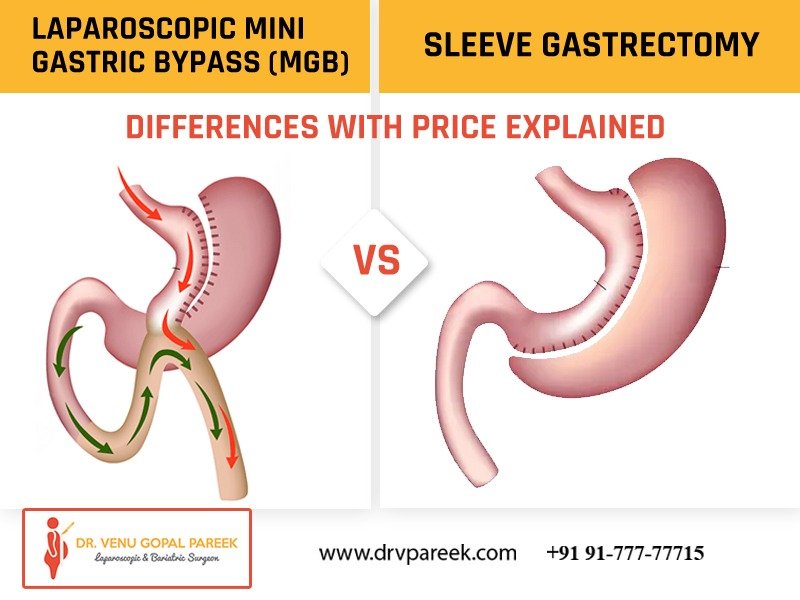
Laparoscopic Mini Gastric Bypass (MGB) vs Sleeve Gastrectomy – Differences With Price Explained
One of the procedures that will help you lose weight is called bariatric surgery. This is an option when you have a lot of weight to lose, significantly when you improve your diet, become more active, and the weight loss pills aren’t working.
Bariatric surgery causes weight loss by limiting the amount of food the stomach can digest. It results in malabsorption of nutrients or a combination of gastric restriction and malabsorption. Bariatric interventions also frequently cause hormonal changes. Most weight-loss surgeries today are performed using a laparoscopic method (minimally invasive surgery).
The most common bariatric surgeries are:-
1)gastric bypass
4)adjustable gastric band
5)biliopancreatic diversion with a duodenal switch.
But two of the most common bariatric interventions are mini gastric bypass and sleeve gastrectomy.
It’s important to compare when deciding between Laparoscopic Mini Gastric Bypass (MGB) vs Sleeve gastrectomy. You need to understand the differences between the two types of bariatric procedures. When examining gastric bypass to the sleeve, there are several factors to consider: Dr Venu Gopal Pareek will help you make the right decisions when considering bariatric surgery.
Here you can know the similarities and differences between these operations.
Traditional gastric bypass surgery

Traditional gastric bypass surgery is the operation most people think of when they hear the term “bariatric surgery”. The stomach is divided into upper and lower sacs. Gastric bypass, also called Roux-en-Y (roo-en-wy) gastric bypass, is a type of weight-loss surgery that involves creating a small pouch from the stomach and connecting the newly created pouch directly to the small intestine. After gastric bypass, swallowed food will go into this small pouch of stomach and then directly into the small intestine, thereby bypassing most of your stomach and the first section of your small intestine.
It promotes weight loss by limiting the number of calories a person can consume per meal (restrictive weight loss) and the number of calories the body can absorb during the digestive process (malabsorption, weight loss).
Mini gastric bypass surgery
Mini gastric bypass surgery works like traditional gastric bypass surgery, which divides the stomach into upper and lower sacs and diverts the small intestine. This allows for restrictive and malabsorptive weight loss.
The main difference between mini gastric bypass surgery and traditional gastric bypass surgery is that the mini version of the surgery is performed modified, including less bowel diversion and anastomoses with a shorter overall time of surgery.
Sleeve Gastrectomy

Laparoscopic sleeve gastrectomy is performed by removing about 80 percent of the stomach. The other remaining part of the stomach is a tubular sac that looks like a banana.
The procedure of mini gastric bypass surgery
The laparoscopic mini-gastric bypass is also known as an One anastomotic gastric bypass (MGB / OAGB). In this surgery, a surgical stapler creates a long gastric pouch that diverts the small intestine in a loop and attaches it to the gastric pouch. Because the sac and anastomosis are slightly larger in this operation, the patient can eat more after this operation. This operation is performed using a laparoscopic technique. 4 to 5 small incisions are made in the abdomen, and a camera is inserted through one of the ports . The surgeon performs the entire operation while looking at the screen with laparoscopic instruments.
The procedure of Sleeve Gastrectomy:
This procedure works by several mechanisms. First, the new stomach pouch has a much smaller volume than a normal stomach and helps to significantly reduce the amount of food (and hence calories) that can be consumed. However, the more significant impact appears to be surgery on gut hormones, which influences hunger, satiety, and blood sugar control.
Short-term studies show that the sleeves are as effective as roux-en-Y gastric bypass for weight loss and diabetes repair or remission.
How mini gastric bypass surgery can lose weight
The following mechanisms lead to weight loss after laparoscopic mini-gastric bypass surgery.
- The narrow longitudinal pouch on the stomach limits the amount of food a person can eat.
- Intestinal diversion leads to malabsorption. This means that the body does not absorb some food eaten by the patient.
- After this operation, certain intestinal hormones are activated and help in weight loss and remission of comorbidities like type 2 diabetes.
- Many other mechanisms and roles for bile acids and gut flora have not been identified to aid in weight loss and remission of comorbidities after this surgery.
How Sleeve bypass surgery can lose weight

Removing your stomach lowers your body’s hormone levels called ghrelin, known as the “hunger hormone.” For example, many people feel less hungry after having a sleeve gastrectomy. Ghrelin also plays a role in blood sugar metabolism, so that people with type II diabetes often experience a decreased need for diabetes drugs (especially oral drugs) after sleeve gastrectomy.
Sleeve gastrectomy does not involve implanting a foreign body, like in Laparoscopic Mini Gastric Bypass (MGB). There is no complicated bowel repositioning as in mini gastric bypass. Most patients find that they can comfortably eat various foods after a reasonable recovery, including fibrous meat and vegetables.
Laparoscopic Mini Gastric Bypass (MGB) vs Sleeve gastrectomy
Both Laparoscopic Mini Gastric Bypass (MGB) vs Sleeve gastrectomy surgery reduce the stomach from its normal size to a small sac. This leads to weight loss in two ways:
- The pouch bags fill up quickly, limiting the amount of food you can eat before you feel full.
- Reduce the amount of ghrelin known as the “hunger hormone.”
The two procedures differ in the way that a new gastric pouch is made.
Laparoscopic Mini Gastric Bypass (MGB):

- Procedure: The doctor attaches a small pouch to the intestine to pass through the stomach.
- Recovery time: 2 to 4 weeks
- Weight loss results: Patients can lose 60 to 80 per cent of their excess body weight in one and a half years.
Sleeve gastrectomy:
- Procedure: The surgeon removes part of the stomach and forms a tubular tube (sleeve).
- Recovery time: 2 to 4 weeks
- Weight Loss Results: Patients should expect to lose weight more slowly and steadily. In the first 12 to 18 months, you can lose 60 to 70 percent of your excess body weight.
Whether you choose a Laparoscopic Mini Gastric Bypass (MGB) or a Sleeve gastrectomy, following a strict diet after the surgery is essential.
Laparoscopic Mini Gastric Bypass (MGB) vs Sleeve gastrectomy: Results and benefits:
Laparoscopic Mini Gastric Bypass (MGB) vs Sleeve gastrectomy can be effective tools to achieve long-term weight loss. Both procedures can help improve conditions related to obesity, including:
- Diabetes
- High blood pressure
- High cholesterol
- Sleep apnea
Which one is right for you?
The type of bariatric surgery which is right for you depends on several factors, including:
- Your weight
- Your medical history
- Any health conditions you may have
- Your expectations
Talk with your doctor about these factors and whether bariatric surgery is an option for you. Together you can decide whether several types of surgery are more suitable for you.
Cost of laparoscopic mini-gastric bypass surgery vs Sleeve gastrectomy

Weight loss surgery has been shown to improve the life expectancy and quality of life of obese patients. Although the surgery itself may seem expensive, it can be viewed as a positive investment for most patients because it often increases employment opportunities, lowers medical costs, and increases cash flow through lower costs of living (lower food costs and reduced medicine cost). Safe and effective bariatric surgery inadequately selected individuals are one of the few genuinely neutral or positive interventions available in medicine today.
The cost of mini laparoscopic gastric bypass surgery and sleeve gastrectomy depends on many factors. These two procedures require a lot of single-use equipment in the form of a stapler, trocar, cartridges, power source, etc. This adds to the cost of both procedures.
The price also depends on the number of days you have to spend in the hospital, the type of room you choose and the hospital where you are operated. Doctors will inform you about the price of surgery after a full evaluation.
Dr Venu Gopal Pareek believes in high-quality care and makes it perfectly safe for you. Don’t worry. You will be in safe hands. Every patient is a VIP to us, and we guarantee that your questions will be considered and answered as early as possible.
It is essential for the patient to be mentally prepared and in a positive mood before surgery. Positive thoughts are beneficial for achieving good results after surgery. So be positive, and Dr Venu Gopal Pareek wishes you all the best in making weight loss different from you.
The cost of both surgeries in Hyderabad at Dr Venu Gopal Pareek is very affordable and reasonable. It depends on the type of room and hospital where we can perform the surgery. Please contact us for more information.
Conclusion:
Laparoscopic Mini Gastric Bypass (MGB) vs Sleeve gastrectomy are types of bariatric surgery. There are similarities between the two procedures, but there are also significant differences. Both operations have advantages and disadvantages.
If you think you might be a candidate for bariatric surgery, talk to your doctor about the risks and benefits of this procedure, and more. With the advice and knowledge of your doctor, you can decide if a Laparoscopic Mini Gastric Bypass (MGB) vs Sleeve gastrectomy is right for you.
For more information about bariatric surgery and its various risks and benefits, contact Dr Venu Gopal Pareek experienced weight loss surgeon. Our team of bariatric surgery specialists will help you find the most suitable order for you. You can contact us at 091777 77715.





